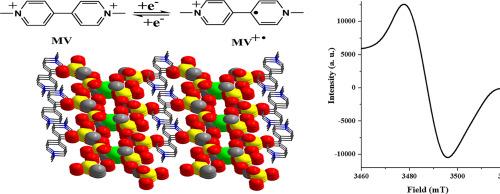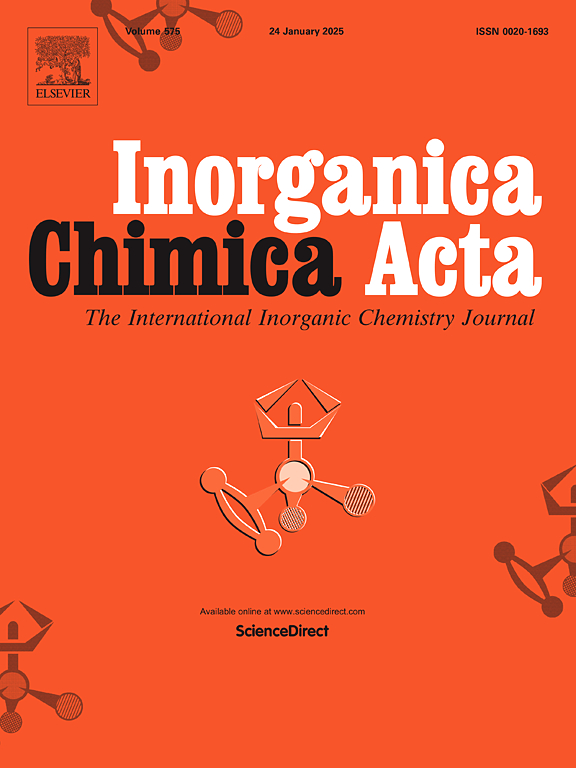甲基磺酸镁分子自组装成氢键链和层状网络
IF 3.2
3区 化学
Q2 CHEMISTRY, INORGANIC & NUCLEAR
引用次数: 0
摘要
研究描述了盐[H2bix][Mg(SO3Me)4(H2O)2](1)和盐共晶[Mg(SO3Me)2(H2O)4][H2bpe·2SO3Me](2·H2bpe·2SO3Me (2a))新型氢键超分子组合的合成和结构特征;2·Me2bpe·2SO3Me (2b)和2·MV·2SO3Me (2c) [bix = 1,4-双(咪唑-1-基甲基)苯,bpe = 1,2-双(4-吡啶基)乙烷,MV = 1,1 ' -二甲基4,4 ' -联吡啶]。x射线晶体学研究表明,1中的八面体络合物阴离子在分子间O- h⋯O氢键中涉及到配位的磺酸盐和反水配体,以提供层状组装,而2a-2c中组成元素之间的相互作用导致一维链。这些框架的空间扩展容纳了具有不同构象特征(间扭式和反式)的有机阳离子。甲基紫素在2c中的整合使框架在固态下具有光致变色特性,在100瓦汞柱灯的照射下,其视觉颜色从白色变为蓝色。该现象归因于甲基紫素自由基阳离子(MV•+)的形成,并通过EPR和UV-vis光谱进行了验证。在常温条件下用1等量水合肼处理2c得到[Mg2(NH2NHCOO)4(H2O)2]·2H2O(3)。3的形成被认为是由于在大气CO2存在的情况下,原位形成的碳酸肼阴离子[N2H3CO2] -取代了前体络合物中的磺酸盐。本文章由计算机程序翻译,如有差异,请以英文原文为准。

Self-assembly of molecular magnesium methanesulfonates into hydrogen-bonded strands and layered networks
The study describes the synthesis and structural features of new hydrogen bonded supramolecular assemblies of the salt [H2bix][Mg(SO3Me)4(H2O)2] (1) and salt cocrystals, [Mg(SO3Me)2(H2O)4][H2bpe·2SO3Me], denoted as 2·H2bpe·2SO3Me (2a); 2·Me2bpe·2SO3Me (2b) and 2·MV·2SO3Me (2c) [bix = 1,4-bis(imidazole-1-ylmethyl)benzene, bpe = 1,2-bis(4-pyridyl)ethane, MV = 1,1′-dimethyl 4,4′-bipyridinium]. X-ray crystallographic study reveals that the octahedral complex anion in 1 involves coordinated sulfonate and trans-aqua ligands in intermolecular O-H⋯O hydrogen bonding to afford a layered assembly, while the interaction between the constituent elements in 2a-2c results in one-dimensional strands. The spatial expanse in these frameworks accommodate the organic cations with distinct conformational features (gauche and trans). The integration of methylviologen in 2c endows the framework with photochromic property in the solid state, as evident by a visual colour change from white to blue upon illumination with 100-watt Hg lamp. The phenomenon is attributed to the formation of methylviologen radical cation (MV•+) and validated by EPR and UV–vis spectroscopy. Treatment of 2c with one equivalent of hydrazine hydrate under ambient conditions gave [Mg2(NH2NHCOO)4(H2O)2]·2H2O (3). The formation of 3 is viewed as resulting from displacement of sulfonate from the precursor complex by in situ formed hydrazido carbonate anion, [N2H3CO2]− in the presence of atmospheric CO2.
求助全文
通过发布文献求助,成功后即可免费获取论文全文。
去求助
来源期刊

Inorganica Chimica Acta
化学-无机化学与核化学
CiteScore
6.00
自引率
3.60%
发文量
440
审稿时长
35 days
期刊介绍:
Inorganica Chimica Acta is an established international forum for all aspects of advanced Inorganic Chemistry. Original papers of high scientific level and interest are published in the form of Articles and Reviews.
Topics covered include:
• chemistry of the main group elements and the d- and f-block metals, including the synthesis, characterization and reactivity of coordination, organometallic, biomimetic, supramolecular coordination compounds, including associated computational studies;
• synthesis, physico-chemical properties, applications of molecule-based nano-scaled clusters and nanomaterials designed using the principles of coordination chemistry, as well as coordination polymers (CPs), metal-organic frameworks (MOFs), metal-organic polyhedra (MPOs);
• reaction mechanisms and physico-chemical investigations computational studies of metalloenzymes and their models;
• applications of inorganic compounds, metallodrugs and molecule-based materials.
Papers composed primarily of structural reports will typically not be considered for publication.
 求助内容:
求助内容: 应助结果提醒方式:
应助结果提醒方式:


